A Fiesta, Famous across Ecuador, yet Unknown to Tourists
- Pinterest474
- Facebook12
- Twitter11
- Reddit0
- Flipboard1
- Email0
- Buffer14
- 512shares
- Like
- Digg
- Del
- Tumblr
- VKontakte
- Buffer
- Love This
- Odnoklassniki
- Meneame
- Blogger
- Amazon
- Yahoo Mail
- Gmail
- AOL
- Newsvine
- HackerNews
- Evernote
- MySpace
- Mail.ru
- Viadeo
- Line
- Comments
- Yummly
- SMS
- Viber
- Telegram
- Subscribe
- Skype
- Facebook Messenger
- Kakao
- LiveJournal
- Yammer
- Edgar
- Fintel
- Mix
- Instapaper
- Copy Link
The Celebration of Octava de Corpus Christi in Pujilí
We went to Pujilí on the recommendation of a fellow overlander. He said there was a ‘dance festival’ on June 17th. In Pujilí we discovered a fiesta celebrating Corpus Christi, involving three colourful parades, and other activities. It is the city’s most important celebration, and people come from all over Ecuador to be involved. The festival incorporates indigenous traditions with the important Catholic Feast Day.
For this reason, the Octava de Corpus Christi in Pujilí is a Patrimonio Cultural Intangible de la Naciòn. (The Corpus Christi Fiesta is a National Intangible Cultural Heritage.) What is Intangible Cultural Heritage?
The importance of intangible cultural heritage is not the cultural manifestation itself but rather the wealth of knowledge and skills that is transmitted through it from one generation to the next. [From the UNESCO WHS site ]
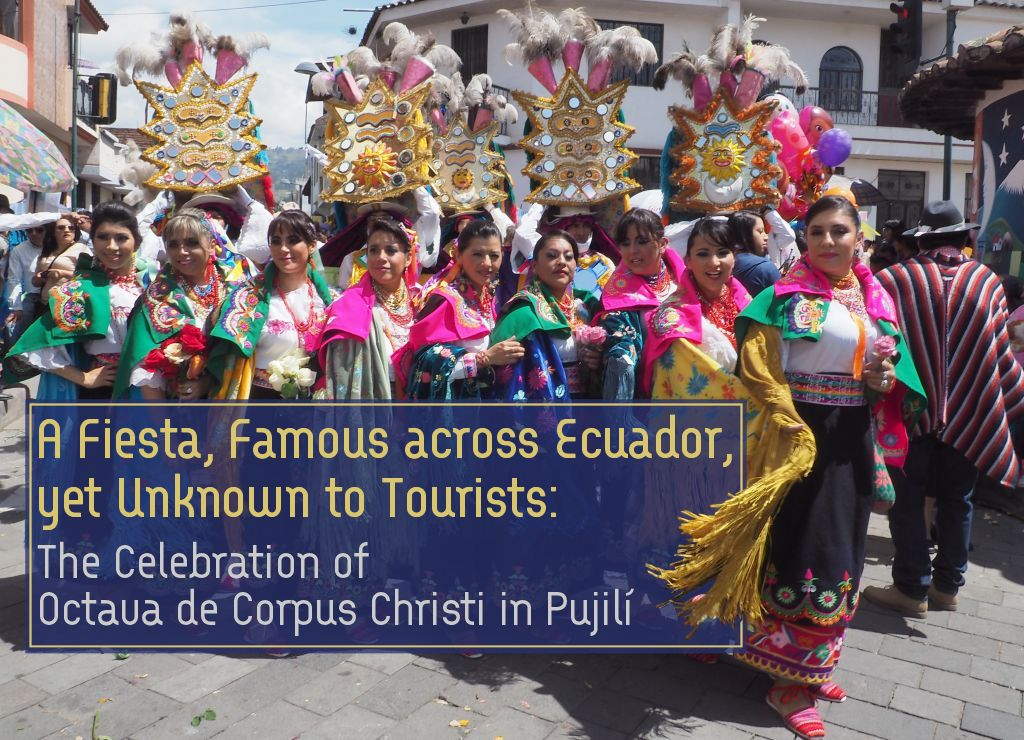
The Corpus Christi fiesta of Pujilí in Cotopaxi Province, is famous right across Ecuador. But it is relatively unknown to tourists outside of the country.
When we planned to go, we had no idea where Pujilí was, or what sort of dance festival to expect. But nowhere is far in Ecuador, and diesel is cheap. We discovered that we must have driven right past it when we drove the Quilotoa circuit in 2008 – it’s the first town on the circuit after leaving Latacunga. Pujilí is the oldest canton in the province of Cotopaxi. According to the tourist information brochure, Pujilí Guía Turística, it is recognised as the Tierra del Danzante y Emporio Musical del Ecuador (land of the dancer and musical emporium of Ecuador).
Pujilí plays a very important role in tourism and cultural development of Ecuador, because of its transcendental attractions such as El Danzante (The Dancer) who is a true historical icon of this area, rooted in popular culture, who identifies their folks with the past.
The parades or processions are so much more – the participants dance along the street to the music of brass bands, or loud speakers carried on vehicles, or just a base drum and a flute. The main character of the festival is El Danzante – The Dancer.
The Dancers of Pujilí
El Danzante is always a man. They are dressed in white lacy trousers and shirts. Over this they wear something like a tunic, which is embellished with a variety of decorations including embroidery, fringes, stones, old coins, mirrors and ribbons. The crown is the most important part of the costume. This head-dress can weigh 10 kilograms. It is a timber construction and heavily adorned. Aspiring Danzantes must train for years to be able to carry this crown, and dance in a parade that can be several hours long.

The Dancers of Pujilí – the costumes are amazing; the headdresses are impressive; the dancers who carry them are astounding.
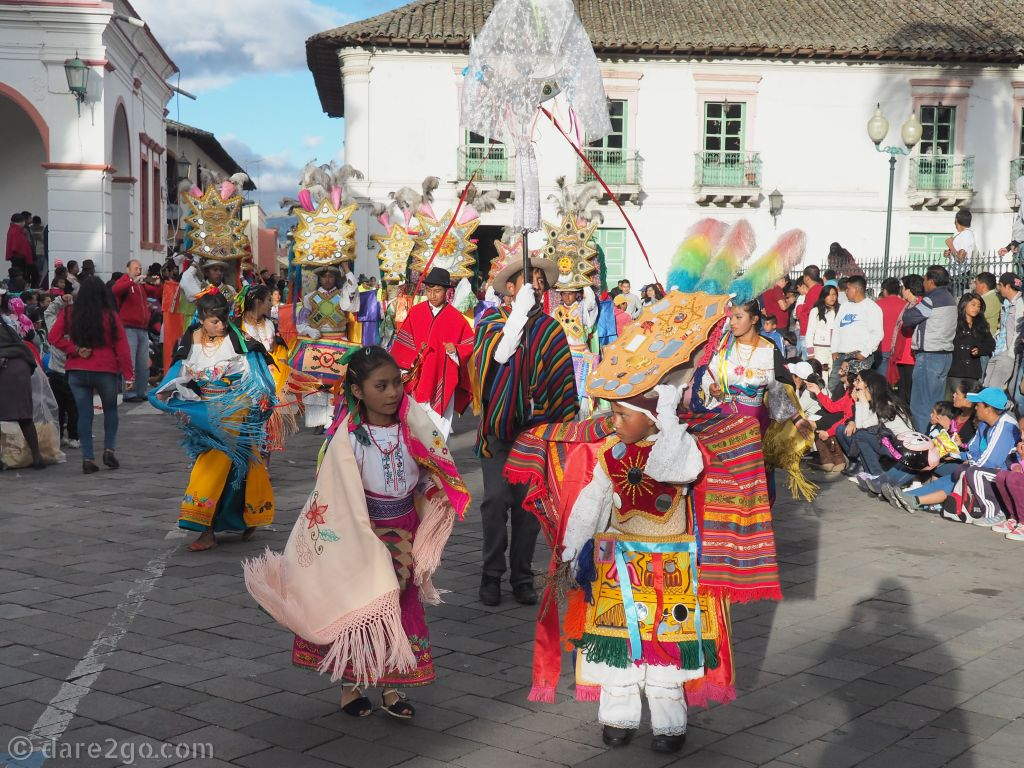
These young ones, taking their roles very seriously – they are seriously cute.
Friday’s Parade: Pregòn de Fiestas – the fiesta is opened
The opening of the weekend fiesta was on Friday afternoon, and it kicked off with a parade involving local schools from the Pujilí region. It began at 3.00pm and continued until about 5.30. Some of the children were so small that they were carried by adults or rode on the back of a truck. It seemed that everyone was involved, they all took their roles seriously, and they were enjoying their time in the limelight. If this was the beginning, it promised to be a very colourful and interesting weekend.
We sat on the edge of the main plaza in front of the Palacio Municipal. Next to me was a young woman, who pointed out the Danzantes very proudly. She explained to me that they are traditional to this area. In this case there were cut down versions of the crown carried by dancing teenagers, and even the smallest boys. El Danzante in training!
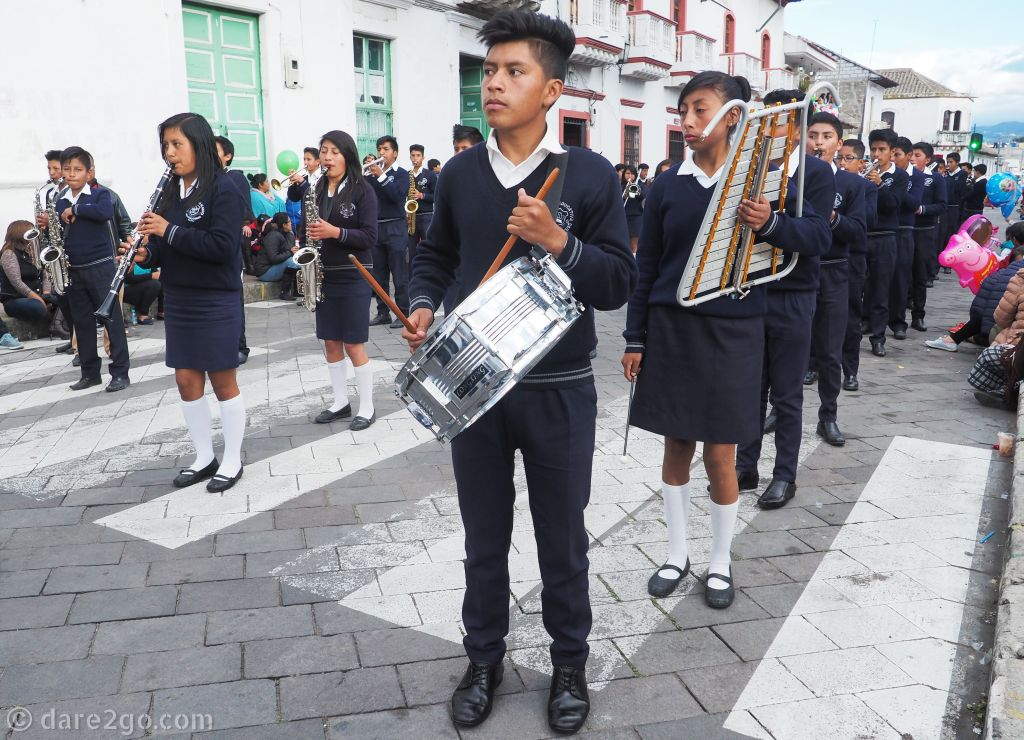
Friday parade in Pujilí: the brass bands were impressive, especially the one from this school, which has ‘produced some of Ecuador’s best musicians’.
The school bands, dressed in neat uniforms for the occasion, were interspersed with the dancers. Their music varied in quality between the groups, but they were all equally very enthusiastic. The parade passed in front of the municipal building. The participants stopped and put on a special performance for the official party, which was seated there. A commentator spoke about each of the groups. When referring to one of the bands, Juergen heard him say that this particular school was renowned for producing some of Ecuador’s best musicians. The band was very impressive.
Please click thumbnails below for a larger photo with description.
Saturday: Folkloric Parade
This appeared to be the biggest procession of the fiesta. It began at around 10 and, when we left our spot at 2, there were still a few groups coming down the street. Can you imagine dancing in the streets non-stop for more than 4 hours – especially the Danzantes, carrying those heavy ‘crowns’?
The participants were groups from the local region, but also from other places all across Ecuador. We think we heard there were also some groups from the neighbouring countries. Many of them showed their local traditions in both costume and dance. It provided an ever-changing, and seemingly never-ending, vista of movement and colour. Although there were various brass bands dotted through the procession, most dancers were accompanied by music blasting from the speakers carried in boots of cars, or on the backs of utes.
Saturday is actually a competition for El Danzante; we never did find out how the judging was done, or who the winners were.
Please click thumbnails below for a larger photo with description.
Sunday: Parade of Indigenous Dancers
The festival of Corpus Christi actually runs for 8 days, with the culmination on Sunday. There is, of course, a mass in the early morning. But Sunday’s parade is perhaps the most important event of the fiesta. It is for the local indigenous people: the Danzantes, accompanied by old men playing the Bombo (bass drum) and the Pingullo (a kind of flute). They are followed the mayor, other dignitaries, and family. There are gifts of sweets and fruit showered upon the onlookers by the participants in the parade, and bottles of celebratory drinks are in plentiful supply. This parade is primarily for giving thanks to Inti (the sun god) and Pacha Mama (mother earth) for good harvests.
The parade ends in Plaza Luis Felipe Chavez, where the ‘Castillos’ have been constructed. These are tall wooden towers, which contain all sorts of treasure on top (fruits, sweets, liquors, soft toys, kitchen appliances, and other gifts). The people try to climb them to claim the booty. Unfortunately, this is such a popular event that we could only see it from a distance, and had no desire to make our way through the huge crowd to see it from a closer viewpoint.
The festivities continued into the afternoon and evening with a bull fight – not our ‘cup of tea’ – and a concert. We did attempt to check out the concert, but there was also a huge crowd and very loud music, so we watched a bit then wandered ‘home’.
Please click thumbnails below for a larger photo with description.
Recommendation
We recommend a visit to this important Fiesta, if you are in Ecuador in June. It is always held on the 3rd weekend, which is nearest the solstice.
Make sure you arrive in plenty of time for the first parade; all three are colourful and joyous celebrations, but completely different.
For more information – in Spanish – we recommend these articles from
El Universo | La Hora | El Comercio
We have published a second gallery (with over 40 photos), depicting individual participants of the ‘Corpus Christi’ festival .
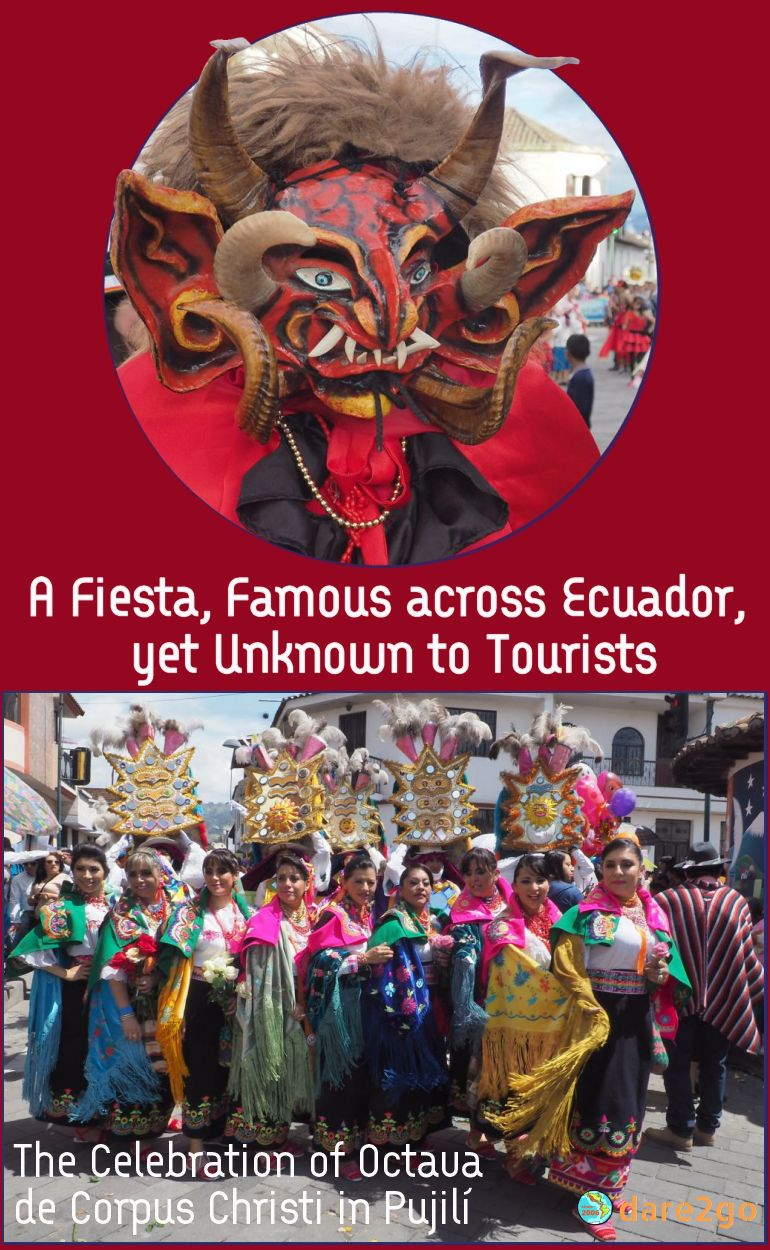
PIN THIS for later!
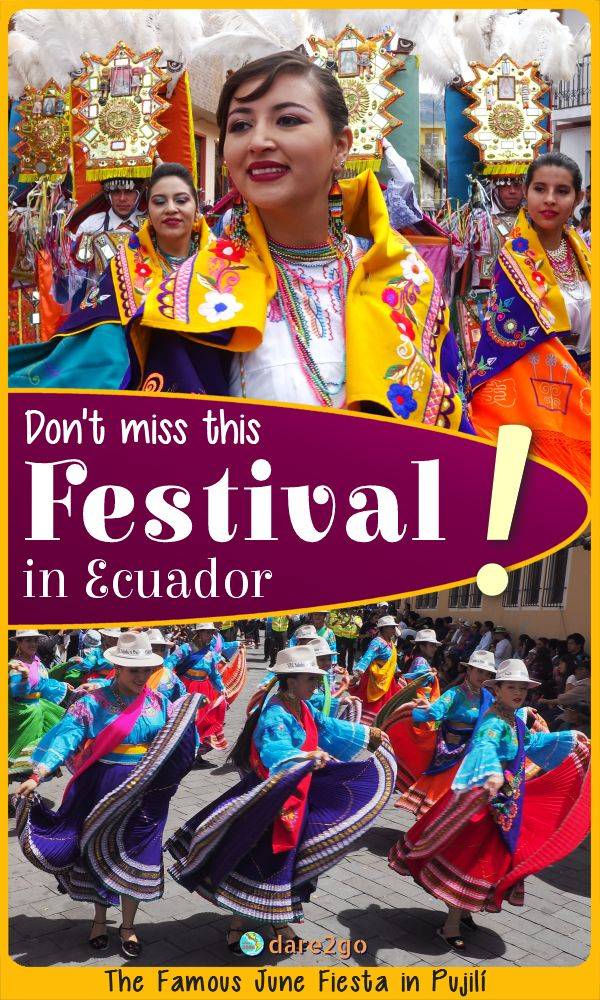
…or PIN this!
- Pinterest474
- Facebook12
- Twitter11
- Reddit0
- Flipboard1
- Email0
- Buffer14
- 512shares
- Like
- Digg
- Del
- Tumblr
- VKontakte
- Buffer
- Love This
- Odnoklassniki
- Meneame
- Blogger
- Amazon
- Yahoo Mail
- Gmail
- AOL
- Newsvine
- HackerNews
- Evernote
- MySpace
- Mail.ru
- Viadeo
- Line
- Comments
- Yummly
- SMS
- Viber
- Telegram
- Subscribe
- Skype
- Facebook Messenger
- Kakao
- LiveJournal
- Yammer
- Edgar
- Fintel
- Mix
- Instapaper
- Copy Link





























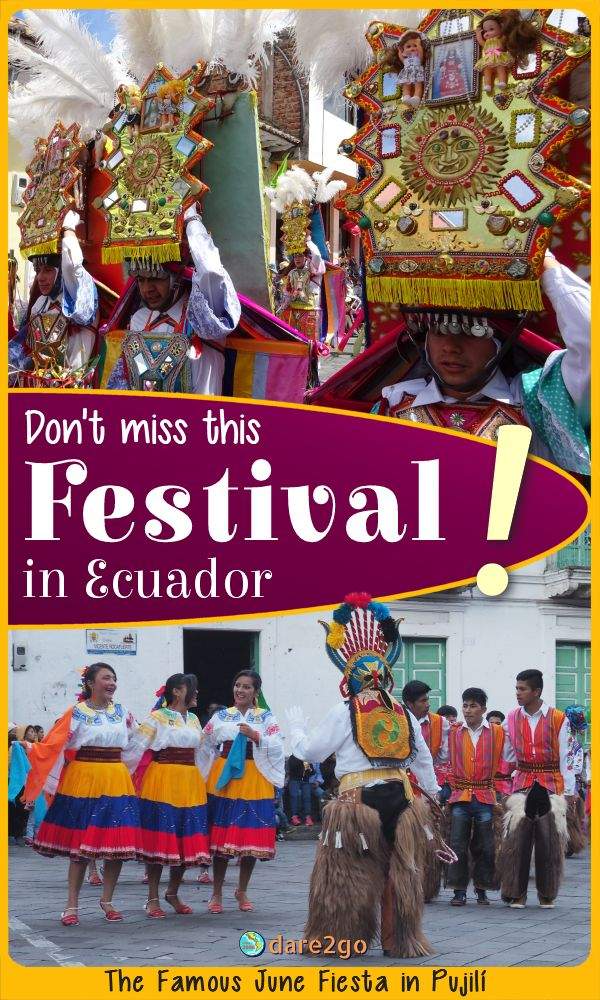





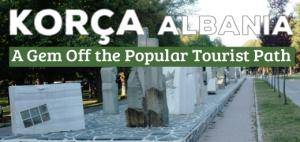






What an entertaining read with fantastic pictures! The festival looks like an incredible riot of colours, music and dancing. Ecuador at its beautiful best :) Reminds me a little bit of the Festival del Yamor in Otavalo which is actually right around the corner – 1st week of Sept. As I recall they do have a Summer Solstice Festival as well, but the harvest festival is much bigger in Otavalo. Will need to check Pujili out if I’m ever back in Ecuador in June! Thanks for sharing :)
We’re glad you enjoyed it. The festival in Pujili was really impressive. We probably would have liked to visit Otavalo also, but we need to leave Ecuador by August 22, so we’ll miss it.
It’s great to know of another reason to return to Ecuador. While we lived there for nearly a year, we were mostly in Quito and would love to see more of the small towns and festivals.
Isn’t it strange that we can live in a place and not really get to know what’s around it. I would recommend the Pujilli Corpus Christi Festival, but there is so much more in Ecuador.
Amazing costumes, and you’re right, the headdresses are crazy huge! We’ve been to Peru and other SA countries but we’ll definitely have to get to Ecuador one day, and maybe include this festival.
Do it Jane. Ecuador has such a lot to offer. The Pujili festival is just one attraction among many.
How gorgeous! I lived in Quito in the 60s, but never heard of this – fascinating!
It was fascinating, Anne. We were pleased to find out about the Corpus Christi festival and to experience it close-up in Pujili.
When I saw Pujili, I knew it was familiar. We stopped there last year when we did the Quilotoa Loop, but not during the parade. Like so many of Ecuador’s festivals, it looks quite colorful. Love the costumes! Not sure we would go to Ecuador in June though , unless we move there.
Well, you know there are a lot of people settling in Ecuador. And, if you did, nowhere is far in Ecuador. I didn’t remember the town from when we drove the Quilotoa Circuit, but we must have passed it. Very glad we discover Pujili this time.
Wow, you hit the jackpot!! A fun and colorful festival without the tourists — only locals. I love the colorful costumes! Excellent article!
Thanks Marilyn. It was very special – we love to come across festivals like this. Pujili was certainly colourful.